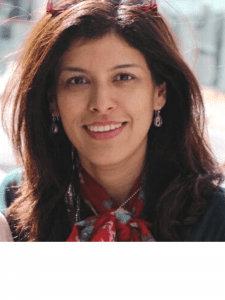Devika Gopal Agge shares her journey with us on career transitions, navigating a job search, and stepping into a new leadership role.
By Felicia Garcia-Hartstein, Aspen Leadership Group
As a woman of color, when I joined the development profession, I was surrounded by people who did not look like me. 15 years later, the diversity of our profession is improving, and now when I look around a meeting room, I see more people of color. But we can do much better, and we need more leaders of color. Aspen Leadership Group strives to do just that by strengthening diversity within nonprofit organizations and supporting the career goals of diverse members of our community. And I am grateful to now be in a position to help others find their dream jobs and to help others step into leadership roles.
I personally love hearing about people’s journeys to their careers in development. We all have unique stories of how we stumbled into development, and whenever I come across another woman of color in our profession, I want to know all about her, which is why I wanted to share Devika Gopal Agge’s journey to her new role. I met Devika through Women of Color in Fundraising and Philanthropy, and at the same time, my colleague, Anne Johnson, Senior Consultant, and Vice President, was helping her find her next role.

Devika is an entrepreneurial development professional with two decades of nonprofit and public-private partnership experience in the United States, United Kingdom, and India. She currently serves as Chief Development Officer at Health In Harmony where she leads and directs the grants, fundraising, blended finance, marketing, and communications efforts to accelerate the organization’s exponential growth to meet the urgency of the climate crisis. She resides in New York City and was born and raised largely in India though she had the opportunity to live and travel in South East Asia with her parents who were in the Diplomatic Corps. I serve as a Search Consultant and the Director for Search Management at Aspen Leadership Group, which helps nonprofit leaders recruit diverse, inclusive, and high-performing advancement teams. Previously I served the University of Rochester as the Executive Director of Presidential Advancement. I reside in Rochester, NY, grew up in Colorado, and am Mexican-American.
You have a business background; how did you successfully transition to philanthropy? And what would you say to others who are trying to do the same?
Transitioning from a business background to a nonprofit one was not as easy as I imagined it to be when I decided to make a move in a more fulfilling direction. I thought my rich experience with skills that are easily transferable would make it similar to switching jobs. However, I learned that the process takes – intentionality, time, and planning. While skills are transferable, they are often used in a different way in the nonprofit arena. In fact, my various volunteering activities helped me to understand the sector, make the connections and understand the lingo better than my work background! So my advice to others who are trying to switch would be to volunteer in the field they are interested in to gain some hands-on experience, join nonprofit networks so you can meet and talk to professionals in the field, and finally read up and become comfortable with the lingo!
What are the most important skills you have developed that have led to your success in philanthropy?
I believe that to succeed in any sector but more so in philanthropy, a person must have the ability to adapt the management style to the situation and people to successfully influence and motivate people inside and outside the organization. In the nonprofit sector, irrespective of our roles, we engage with a wide range of stakeholders from different sectors including corporate, government, and non-government sectors. Moreover, we are called upon to engage employees, volunteers, and donors in different ways. So it is important to be able to adapt our style to match the lingo of each of these stakeholders to successfully manage and motivate them. In addition to this, in a nonprofit, people are always operating in a situation of financial constraint and so being able to multitask and manage a wide range of activities becomes instrumental to success.
Before you joined Health in Harmony, how did you approach and navigate your job search? How did you determine what kind of organization you wanted to work for?
As I mentioned before, whether it is a job search or a career transition, the process takes – intentionality, time, and planning. With the onset of the COVID-19 pandemic, this became more important than ever. The rules for finding a job changed dramatically as virtual interviews became the norm, locations became secondary, and remote working became a mainstream option. I had to find new ways of networking and learn how to work the e-rooms to build relationships when I was just a ‘Hollywood’ square on someone’s screen and many times not even that if it was a Webinar. The completely digital setting of job applications and interviews also required re-working established strategies as it is harder to read the ‘room’. In all of this, I learned that recruiters like Aspen Leadership Group and networks like Women of Color in Fundraising and Philanthropy were critical to help me learn, navigate uncharted waters, and make me ready for the opportunity when it does arise.
The ‘right’ organization to work for varies from person to person depending on the priority they place on mission, financial, and organizational aspects. For me, my personal mission needs to align with the organization’s mission and I need to be able to relate to and build relationships with the team. The mission is typically an easy first filter, after which, I really try to find out more about the people who work there and to understand why people enjoy working there. Health In Harmony checked off both these boxes and though I am only 6-months into this role, I find myself thriving and enjoying every minute.
Since you are in a newly established role aimed at building a development program, how did you determine what to tackle first and what to invest in first, while also staying focused on growing the bottom line?
I approach my work with a binding commitment to building high-functioning teams and maintaining strong, mission-driven institutions. Given this, I believe that every decision and action should support and further the mission and vision of the organization. For Health In Harmony, the mission is to rapidly scale their disruptive planetary health model for which they need to expand their budget by ~50% annually. To help me to better understand what to tackle first, I did a deep dive into the revenue stream, which I found was almost evenly split between grants and individual giving. Further analysis suggested that donors usually support Health in Harmony because they have a personal driver connected with the mission, and they believe in the interconnectedness of the model which breaks down the siloed approach to investment to listen to and invest precisely in the solutions of the traditional and indigenous communities. Once we had identified these, the next steps were all about finding ways to continue to grow both grants and individual giving in a meaningful way while laying the foundation for opening up other streams of growth such as corporate giving, capital campaigns, and eventually blended financing.
How has your cultural background had an impact on your career?
I have lived and worked in three continents. Through these experiences, I have learned that the role of culture in careers is rather complex as different cultures have different ideas about the meaning of a career and the value placed on the importance of work and the type of work. For me, thankfully my family has a much higher tolerance for outside-the-norm ideas and experimentation and has always been very supportive of individual choices. The only ‘requirement’ if any is that I give my best. This value has served as my touchstone and helped me overcome the many uncertainties and challenges I faced when I first came to the United States. Coming to a new country with no family or friends was quite difficult, however, MIT really helped me build the social network I needed to succeed. Looking back I realize I was very fortunate to go into an institution that had an empowering educational environment that supported people to achieve their dreams. This experience early on helped me appreciate the life-changing power of connecting people and opportunities and in turn, has defined my career choices.
How do we, women of color, help other women of color step into leadership roles?
Learning how to create mental proximity through conversation is an important skill that is essential for leaders to successfully integrate into ambitious organizations. Women of color can help other women of color step into leadership roles by helping them learn this skill, mentoring, and networking opportunities.
Globalization and new technologies mean that we may not always have or need physical proximity. This emphasizes the need to create mental proximity, i.e., an emotional connection with employees for successful integration and continued success as a leader. How do we create mental proximity? Through ordinary conversation that reflects the essential attributes of interpersonal conversation: intimacy, interactivity, inclusion, and intentionality. This concept has been credibly analyzed and argued by Groysberg and Slind in “Leadership Is a Conversation,” published in the June 2012 edition of Harvard Business Review. This type of organizational conversation is a pivot from the traditional top-down approach of corporate communication. It’s casual, transparent, and requires the leader to know when to stop talking and when to start listening. It takes courage and humility but done right it creates a spirit of inclusion that fosters engaged employees who become brand ambassadors and thought leaders for the company.
Organizational conversation is easily learned through practice. Leadership coaches have compared this skill to learning how to ride a bike. No matter how many books you read about how to ride a bike, they are of little use when it comes to actually getting on the bike. You will fall several times but to learn, you just need to find the heart to keep getting back on till you find your balance.


